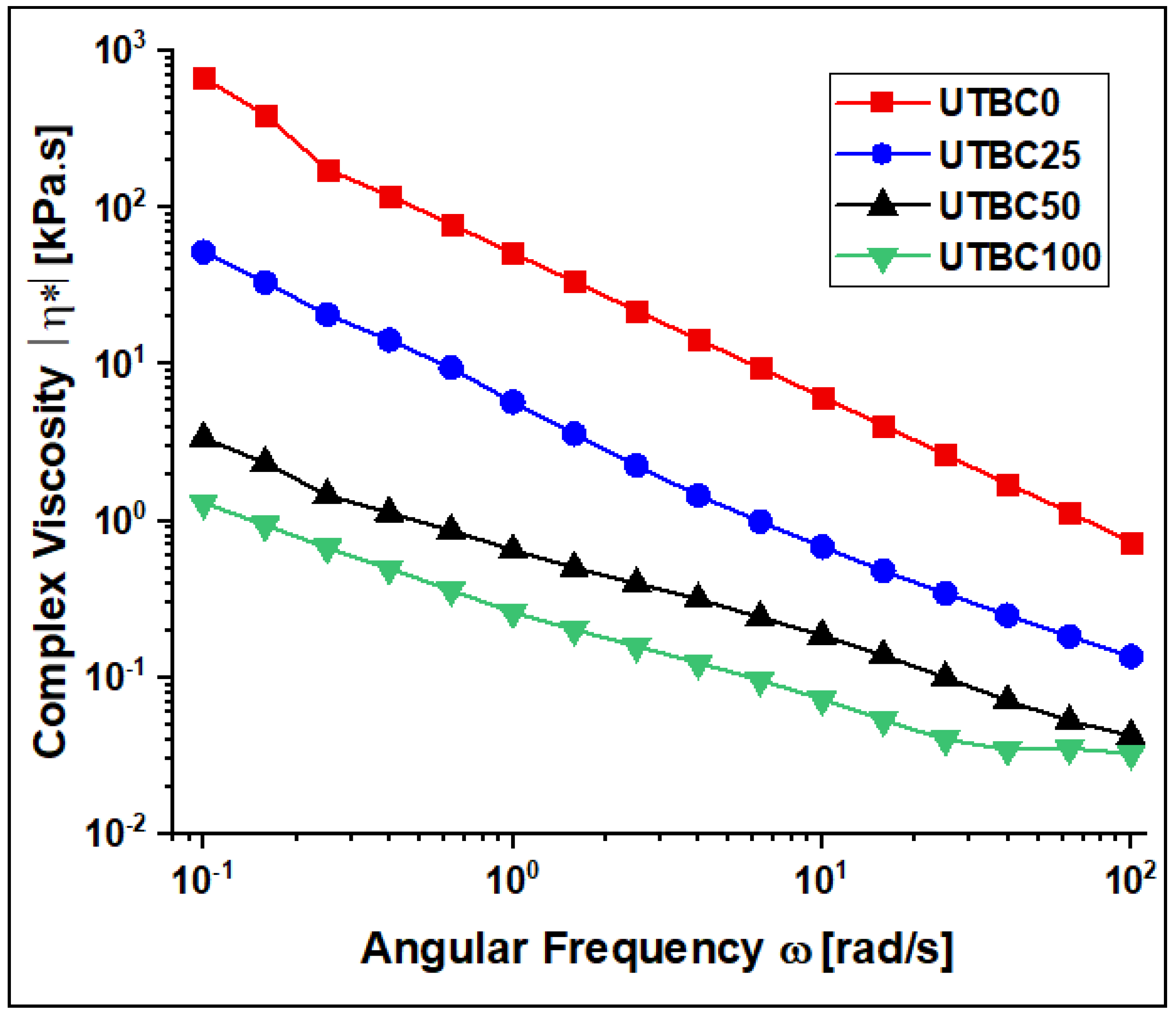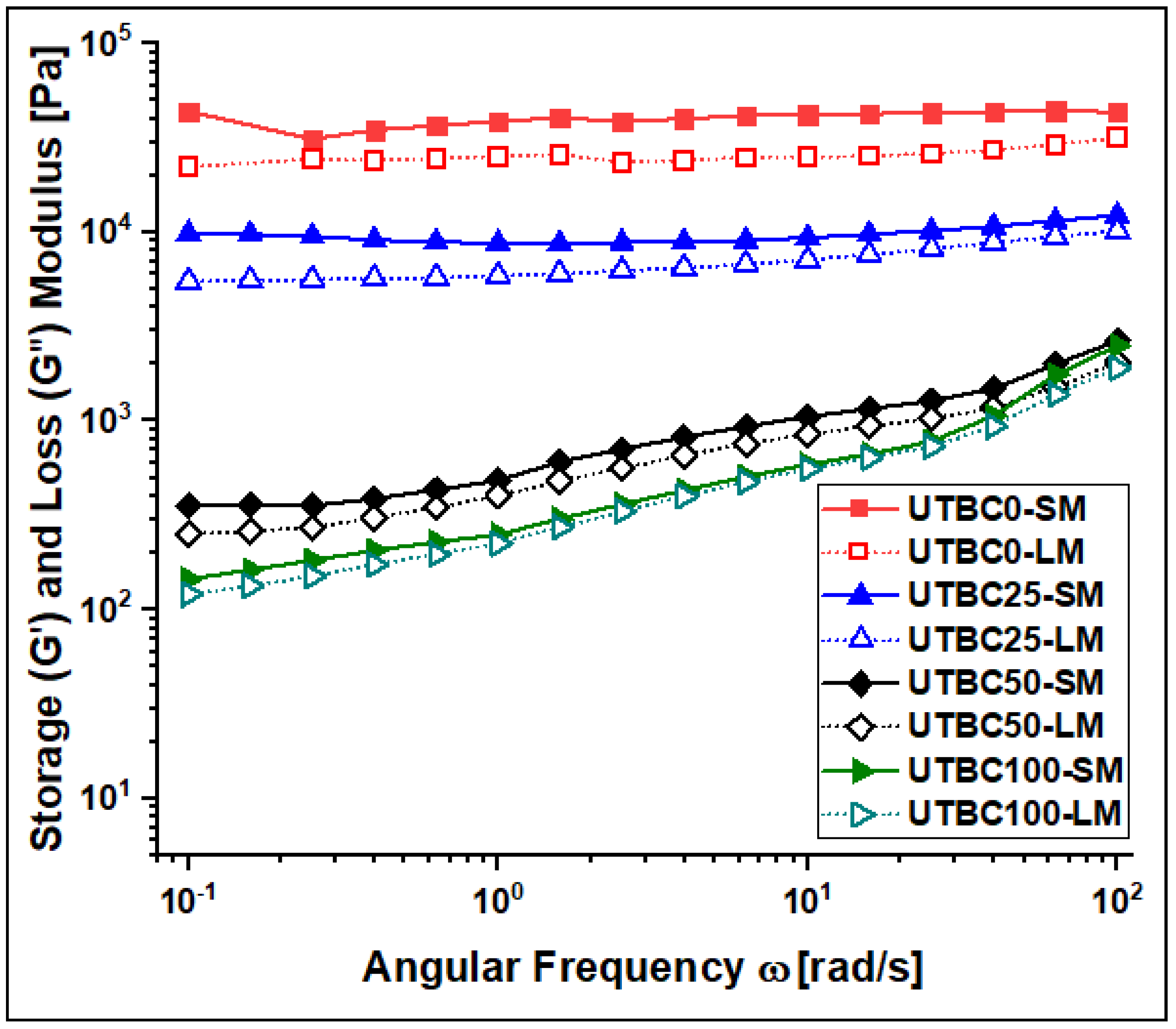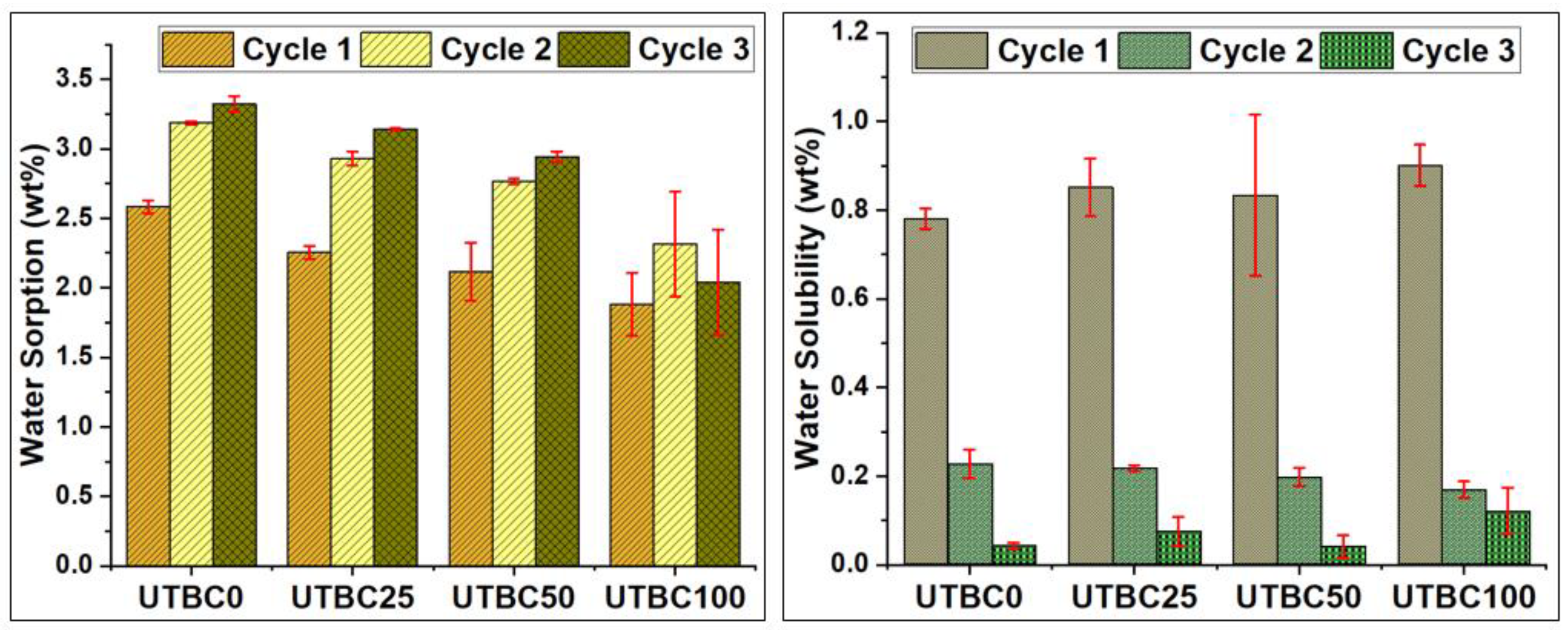Viscosity, Degree of Polymerization, Water Uptake, and Water Solubility Studies on Experimental Dichloro-BisGMA-Based Dental Composites
Abstract
1. Introduction
2. Materials and Methods
2.1. Materials
2.2. Methods
2.2.1. Synthesis of dCl-BisGMA
2.2.2. Modification of Silica Nanoparticles
2.2.3. Preparation of Resin Composites
2.3. Analytical Experiments
2.3.1. Rheological Test
2.3.2. Degree of Conversion
2.3.3. Water Sorption and Water Solubility
2.4. Statistical Analysis
3. Results and Discussion
3.1. dCl-BisGMA Properties
3.2. Rheological Properties of UTBC Composites
3.3. DC Analysis
3.4. Water Sorption and Solubility
4. Conclusions
Author Contributions
Funding
Data Availability Statement
Acknowledgments
Conflicts of Interest
References
- Pratap, B.; Gupta, R.K.; Bhardwaj, B.; Nag, M. Resin based restorative dental materials: Characteristics and future perspectives. Jpn. Dent. Sci. Rev. 2019, 55, 126–138. [Google Scholar] [CrossRef] [PubMed]
- Al-Odayni, A.-B.; Alfotawi, R.; Khan, R.; Saeed, W.S.; Al-Kahtani, A.; Aouak, T.; Alrahlah, A. Synthesis of chemically modified BisGMA analog with low viscosity and potential physical and biological properties for dental resin composite. Dent. Mater. 2019, 35, 1532–1544. [Google Scholar] [CrossRef]
- Khatri, C.A.; Stansbury, J.W.; Schultheisz, C.R.; Antonucci, J.M. Synthesis, characterization and evaluation of urethane derivatives of Bis-GMA. Dent. Mater. 2003, 19, 584–588. [Google Scholar] [CrossRef]
- Peutzfeldt, A. Resin composites in dentistry: The monomer systems. Eur. J. Oral Sci. 1997, 105, 97–116. [Google Scholar] [CrossRef] [PubMed]
- Podgórski, M. Synthesis and characterization of novel dimethacrylates of different chain lengths as possible dental resins. Dent. Mater. 2010, 26, e188–e194. [Google Scholar] [CrossRef] [PubMed]
- Kim, J.; Kim, L.; Kim, C.; Cho, B.; Kim, O. Characteristics of novel dental composites containing 2, 2-bis [4-(2-methoxy-3-methacryloyloxy propoxy) phenyl] propane as a base resin. Biomacromolecules 2006, 7, 154–160. [Google Scholar] [CrossRef] [PubMed]
- Buruiana, T.; Melinte, V.; Jitaru, F.; Aldea, H.; Buruiana, E.C. Photopolymerization experiments and properties of some urethane/urea methacrylates tested in dental composites. J. Compos. Mater. 2012, 46, 371–382. [Google Scholar] [CrossRef]
- Melinte, V.; Buruiana, T.; Chibac, A.; Mares, M.; Aldea, H.; Buruiana, E.C. New acid BisGMA analogs for dental adhesive applications with antimicrobial activity. Dent. Mater. 2016, 32, e314–e326. [Google Scholar] [CrossRef]
- Rivera-Torres, F.; Vera-Graziano, R. Effects of water on the long-term properties of Bis-GMA and silylated-(Bis-GMA) polymers. J. Appl. Polym. Sci. 2008, 107, 1169–1178. [Google Scholar] [CrossRef]
- Wang, R.; Zhu, M.; Bao, S.; Liu, F.; Jiang, X.; Zhu, M. Synthesis of two Bis-GMA derivates with different size substituents as potential monomer to reduce the polymerization shrinkage of dental restorative composites. J. Mater. Sci. Res. 2013, 2, 12. [Google Scholar] [CrossRef][Green Version]
- Jeon, M.; Yoo, S.; Kim, J.; Kim, C.; Cho, B. Dental restorative composites fabricated from a novel organic matrix without an additional diluent. Biomacromolecules 2007, 8, 2571–2575. [Google Scholar] [CrossRef] [PubMed]
- Srivastava, R.; Wolska, J.; Walkowiak-Kulikowska, J.; Koroniak, H.; Sun, Y. Fluorinated bis-GMA as potential monomers for dental restorative composite materials. Eur. Polym. J. 2017, 90, 334–343. [Google Scholar] [CrossRef]
- Al-Odayni, A.-B.; Saeed, W.S.; Ahmed, A.Y.B.H.; Alrahlah, A.; Al-Kahtani, A.; Aouak, T. New Monomer Based on Eugenol Methacrylate, Synthesis, Polymerization and Copolymerization with Methyl Methacrylate–Characterization and Thermal Properties. Polymers 2020, 12, 160. [Google Scholar] [CrossRef] [PubMed]
- Pereira, S.G.; Osorio, R.; Toledano, M.; Cabrerizo-Vílchez, M.A.; Nunes, T.G.; Kalachandra, S. Novel light-cured resins and composites with improved physicochemical properties. Dent. Mater. 2007, 23, 1189–1198. [Google Scholar] [CrossRef]
- Alrahlah, A.; Al-Odayni, A.-B.; Al-Mutairi, H.F.; Almousa, B.M.; Alsubaie, F.S.; Khan, R.; Saeed, W.S. A Low-Viscosity BisGMA Derivative for Resin Composites: Synthesis, Characterization, and Evaluation of Its Rheological Properties. Materials 2021, 14, 338. [Google Scholar] [CrossRef] [PubMed]
- Atai, M.; Pahlavan, A.; Moin, N. Nano-porous thermally sintered nano silica as novel fillers for dental composites. Dent. Mater. 2012, 28, 133–145. [Google Scholar] [CrossRef] [PubMed]
- Kleczewska, J.; Bieliński, D.; Nowak, J.; Sokołowski, J.; Łukomska-Szymańska, M. Dental composites based on dimethacrylate resins reinforced by nanoparticulate silica. Polym. Polym. Compos. 2016, 24, 411–418. [Google Scholar] [CrossRef]
- Zanchi, C.H.; Ogliari, F.A.; e Silva, R.M.; Lund, R.G.; Machado, H.H.; Prati, C.; Carreño, N.L.V.; Piva, E. Effect of the silane concentration on the selected properties of an experimental microfilled composite resin. Appl. Adhes. Sci. 2015, 3, 27. [Google Scholar] [CrossRef]
- Alrahlah, A.; Khan, R.; Al-Odayni, A.-B.; Saeed, W.S.; Bautista, L.S.; Vohra, F. Evaluation of Synergic Potential of rGO/SiO2 as Hybrid Filler for BisGMA/TEGDMA Dental Composites. Polymers 2020, 12, 3025. [Google Scholar] [CrossRef] [PubMed]
- Rostamzadeh, P.; Mirabedini, S.M.; Esfandeh, M. APS-silane modification of silica nanoparticles: Effect of treatment’s variables on the grafting content and colloidal stability of the nanoparticles. J. Coat. Technol. Res. 2014, 11, 651–660. [Google Scholar] [CrossRef]
- Standards, I. ISO 4049 Dentistry—Polymer based restorative materials. Int. Organ. Stand. 2009, 4, 1–28. [Google Scholar]
- Appel, R. Tertiary Phosphane/Tetrachloromethane, a Versatile Reagent for Chlorination, Dehydration, and P N Linkage. Angew. Chem. Int. Ed. Engl. 1975, 14, 801–811. [Google Scholar] [CrossRef]
- Castro, B.R. Replacement of alcoholic hydroxyl groups by halogens and other nucleophiles via oxyphosphonium intermediates. Org. React. 2004, 29, 1–162. [Google Scholar]
- Meier, R.; Kirdar, C.; Rudolph, N.; Zaremba, S.; Drechsler, K. Investigation of the shear thinning behavior of epoxy resins for utilization in vibration assisted liquid composite molding processes. In AIP Conference Proceedings; American Institute of Physics: College Park, MD, USA, 2014; pp. 458–462. [Google Scholar]
- Vlachopoulos, J.; Strutt, D. The Role of Rheology in Polymer Extrusion. In Proceedings of the New Technology for Extrusion Conference; pp. 20–21.
- Lee, I.-B.; Son, H.-H.; Um, C.-M. Rheologic properties of flowable, conventional hybrid, and condensable composite resins. Dent. Mater. 2003, 19, 298–307. [Google Scholar] [CrossRef]
- Haddadi, H.; Famili, M.H.N.; Nazokdast, E.; Moradi, S. Chemorheological analyses of a reaction injection moulding polyurethane formulation. Iran. Polym. J. 2006, 15, 967–977. [Google Scholar]
- Kumar, S.; Zindani, D.; Bhowmik, S. Investigation of mechanical and viscoelastic properties of flax-and ramie-reinforced green composites for orthopedic implants. J. Mater. Eng. Perform. 2020, 29, 3161–3171. [Google Scholar] [CrossRef]
- Zhu, J.; Wei, S.; Yadav, A.; Guo, Z. Rheological behaviors and electrical conductivity of epoxy resin nanocomposites suspended with in-situ stabilized carbon nanofibers. Polymer 2010, 51, 2643–2651. [Google Scholar] [CrossRef]
- Halvorson, R.H.; Erickson, R.L.; Davidson, C.L. The effect of filler and silane content on conversion of resin-based composite. Dent. Mater. 2003, 19, 327–333. [Google Scholar] [CrossRef]
- Turssi, C.; Ferracane, J.; Vogel, K. Filler features and their effects on wear and degree of conversion of particulate dental resin composites. Biomaterials 2005, 26, 4932–4937. [Google Scholar] [CrossRef]
- Rastelli, A.N.; Jacomassi, D.P.; Faloni, A.P.S.; Queiroz, T.P.; Rojas, S.S.; Bernardi, M.I.B.; Bagnato, V.S.; Hernandes, A.C. The filler content of the dental composite resins and their influence on different properties. Microsc. Res. Tech. 2012, 75, 758–765. [Google Scholar] [CrossRef]
- Bociong, K.; Szczesio, A.; Krasowski, M.; Sokolowski, J. The influence of filler amount on selected properties of new experimental resin dental composite. Open Chem. 2018, 16, 905–911. [Google Scholar] [CrossRef]
- Lempel, E.; Czibulya, Z.; Kovács, B.; Szalma, J.; Tóth, Á.; Kunsági-Máté, S.; Varga, Z.; Böddi, K. Degree of conversion and BisGMA, TEGDMA, UDMA elution from flowable bulk fill composites. Int. J. Mol. Sci. 2016, 17, 732. [Google Scholar] [CrossRef] [PubMed]
- Silikas, N.; Eliades, G.; Watts, D. Light intensity effects on resin-composite degree of conversion and shrinkage strain. Dent. Mater. 2000, 16, 292–296. [Google Scholar] [CrossRef]
- Moldovan, M.; Balazsi, R.; Soanca, A.; Roman, A.; Sarosi, C.; Prodan, D.; Vlassa, M.; Cojocaru, I.; Saceleanu, V.; Cristescu, I. Evaluation of the degree of conversion, residual monomers and mechanical properties of some light-cured dental resin composites. Materials 2019, 12, 2109. [Google Scholar] [CrossRef] [PubMed]
- Galvão, M.R.; Caldas, S.G.F.R.; Bagnato, V.S.; de Souza Rastelli, A.N.; de Andrade, M.F. Evaluation of degree of conversion and hardness of dental composites photo-activated with different light guide tips. Eur. J. Dent. 2013, 7, 86. [Google Scholar] [PubMed]
- Pałka, K.; Kleczewska, J.; Sasimowski, E.; Belcarz, A.; Przekora, A. Improved Fracture Toughness and Conversion Degree of Resin-Based Dental Composites after Modification with Liquid Rubber. Materials 2020, 13, 2704. [Google Scholar] [CrossRef]
- Kowalska, A.; Sokolowski, J.; Bociong, K. The Photoinitiators Used in Resin Based Dental Composite—A Review and Future Perspectives. Polymers 2021, 13, 470. [Google Scholar] [CrossRef]
- Pfeifer, C.S.; Shelton, Z.R.; Braga, R.R.; Windmoller, D.; Machado, J.C.; Stansbury, J.W. Characterization of dimethacrylate polymeric networks: A study of the crosslinked structure formed by monomers used in dental composites. Eur. Polym. J. 2011, 47, 162–170. [Google Scholar] [CrossRef] [PubMed]
- Young, J.S.; Kannurpatti, A.R.; Bowman, C.N. Effect of comonomer concentration and functionality on photopolymerization rates, mechanical properties and heterogeneity of the polymer. Macromol. Chem. Phys. 1998, 199, 1043–1049. [Google Scholar] [CrossRef]
- Silva, E.M.d.; Almeida, G.S.; Poskus, L.T.; Guimarães, J.G.A. Relationship between the degree of conversion, solubility and salivary sorption of a hybrid and a nanofilled resin composite. J. Appl. Oral Sci. 2008, 16, 161–166. [Google Scholar] [CrossRef] [PubMed]
- Kumar, N.; Sangi, L. Water sorption, solubility, and resultant change in strength among three resin-based dental composites. J. Investig. Clin. Dent. 2014, 5, 144–150. [Google Scholar] [CrossRef] [PubMed]





| Composite | Resin Composition (wt%) | Replacement (%) = × 100 | |||
|---|---|---|---|---|---|
| UDMA | TEGDMA | BisGMA (B) | dCl-BisGMA (C) | ||
| UTBC0 | 20 | 60 | 20 | 0 | 0 |
| UTBC25 | 20 | 60 | 15 | 5 | 25 |
| UTBC50 | 20 | 60 | 10 | 10 | 50 |
| UTBC100 | 20 | 60 | 0 | 20 | 100 |
| Composite | DC (%) (n = 4) | Complex Viscosity (kPa·s); at ω = 1.0 (rad/s), (n = 4) | WSP (wt/wt)% (n = 5) | WSL (wt/wt)% (n = 5) | ||||
|---|---|---|---|---|---|---|---|---|
| 1st Cycle | 2nd Cycle | 3rd Cycle | 1st Cycle | 2nd Cycle | 3rd Cycle | |||
| UTBC0 | 74.18 (2.87) a | 47.29 (5.92) a | 2.58 (0.10) a,b,A | 3.19 (0.03) a,b,B | 3.32 (0.13) a,b,C | 0.78 (0.05) a,A | 0.23 (0.07) a,B | 0.04 (0.02) a,C |
| UTBC25 | 75.27 (4.77) a | 5.36 (0.55) b | 2.26 (0.11) a,A | 2.93 (0.11) a,B | 3.14 (0.02) a,C | 0.85 (0.14) b,A | 0.22 (0.02) b,B | 0.07 (0.07) b,C |
| UTBC50 | 77.36 (5.02) a | 0.63 (0.07) b | 2.11 (0.47) a,A | 2.76 (0.05) a,B | 2.94 (0.08) a,C | 0.82 (0.41) c,A | 0.19 (0.05) c,B | 0.04 (0.06) c,C |
| UTBC100 | 79.01 (4.61) a | 0.30 (0.05) b | 1.88 (0.50) a,c,A,D | 2.31 (0.85) a,c,B | 2.04 (0.85) a,c,A,D | 0.90 (0.10) d,A | 0.17 (0.04) d,B | 0.12 (0.12) d,C |
Publisher’s Note: MDPI stays neutral with regard to jurisdictional claims in published maps and institutional affiliations. |
© 2021 by the authors. Licensee MDPI, Basel, Switzerland. This article is an open access article distributed under the terms and conditions of the Creative Commons Attribution (CC BY) license (https://creativecommons.org/licenses/by/4.0/).
Share and Cite
Al-Odayni, A.-B.; Saeed, W.S.; Khan, R.; Al-Kahtani, A.; Aouak, T.; Almutairi, K.; Alrahlah, A. Viscosity, Degree of Polymerization, Water Uptake, and Water Solubility Studies on Experimental Dichloro-BisGMA-Based Dental Composites. Appl. Sci. 2021, 11, 3577. https://doi.org/10.3390/app11083577
Al-Odayni A-B, Saeed WS, Khan R, Al-Kahtani A, Aouak T, Almutairi K, Alrahlah A. Viscosity, Degree of Polymerization, Water Uptake, and Water Solubility Studies on Experimental Dichloro-BisGMA-Based Dental Composites. Applied Sciences. 2021; 11(8):3577. https://doi.org/10.3390/app11083577
Chicago/Turabian StyleAl-Odayni, Abdel-Basit, Waseem Sharaf Saeed, Rawaiz Khan, Abdullah Al-Kahtani, Taieb Aouak, Khalid Almutairi, and Ali Alrahlah. 2021. "Viscosity, Degree of Polymerization, Water Uptake, and Water Solubility Studies on Experimental Dichloro-BisGMA-Based Dental Composites" Applied Sciences 11, no. 8: 3577. https://doi.org/10.3390/app11083577
APA StyleAl-Odayni, A.-B., Saeed, W. S., Khan, R., Al-Kahtani, A., Aouak, T., Almutairi, K., & Alrahlah, A. (2021). Viscosity, Degree of Polymerization, Water Uptake, and Water Solubility Studies on Experimental Dichloro-BisGMA-Based Dental Composites. Applied Sciences, 11(8), 3577. https://doi.org/10.3390/app11083577









